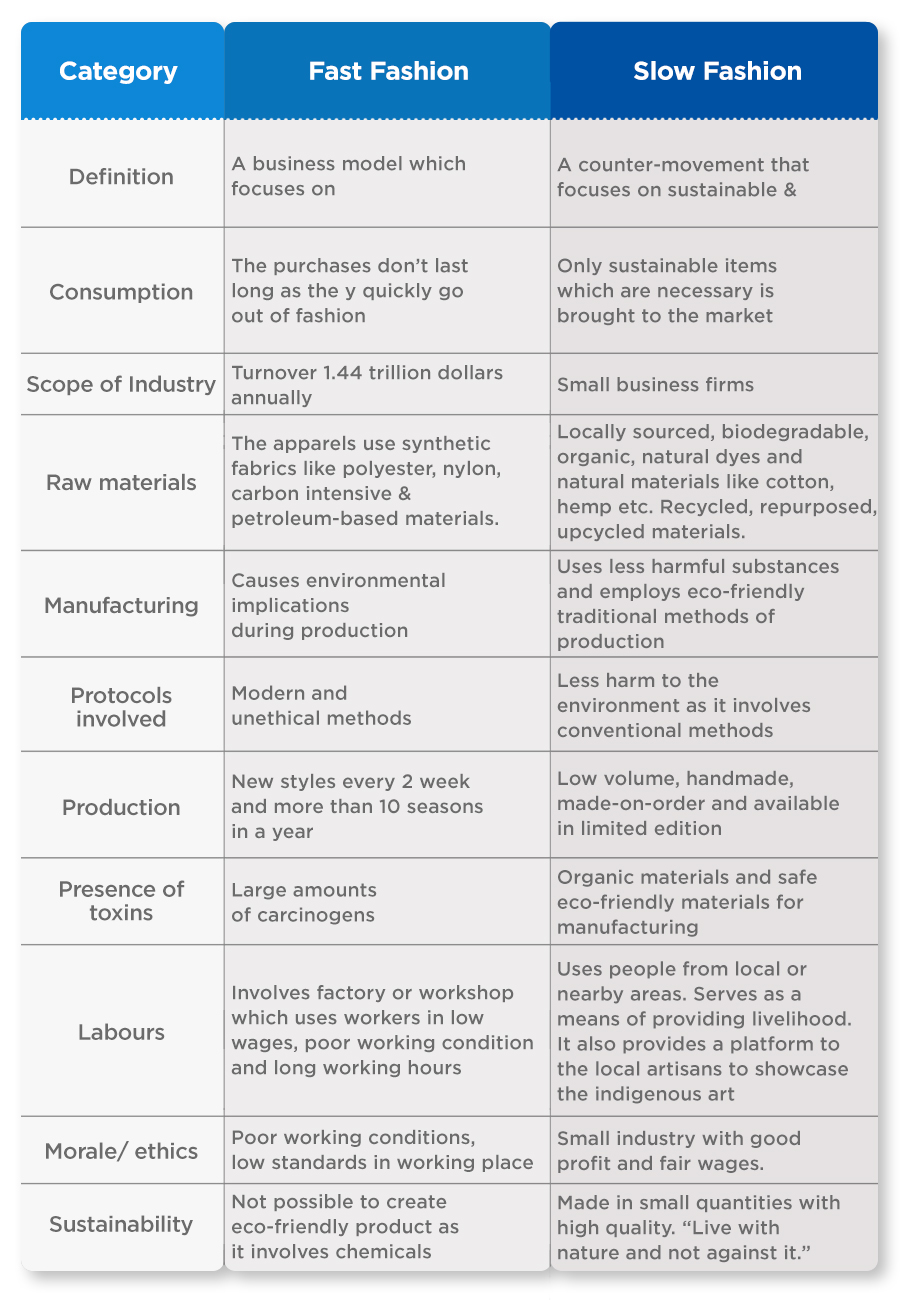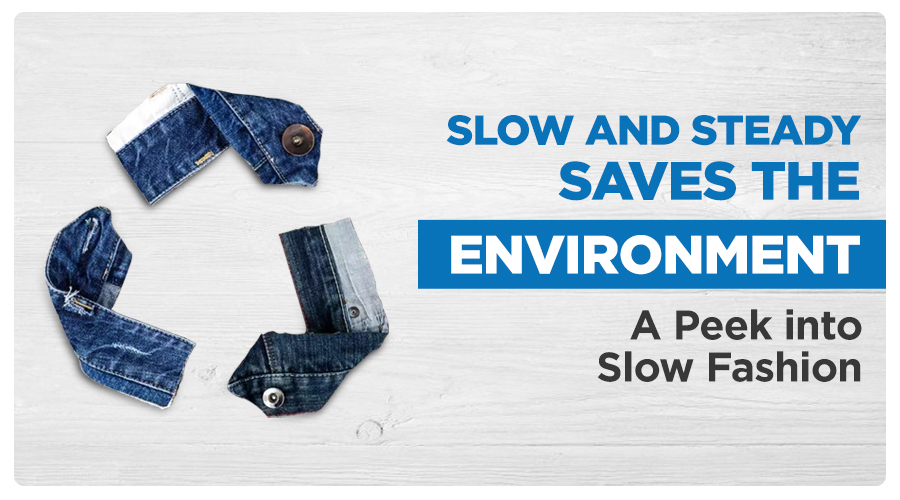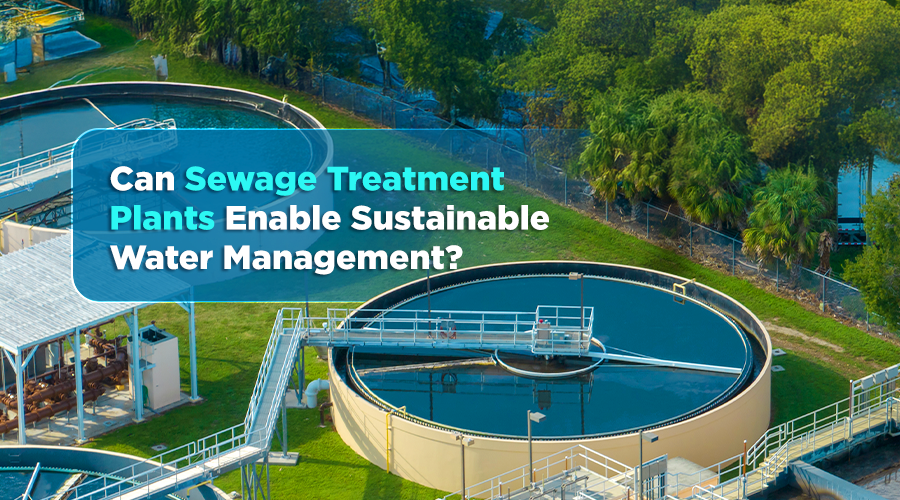“Ethical & Slow Fashion is the recognition that there are human beings behind the clothes that we wear.”
-Elizabeth Joy
What Is Slow Fashion & Why Does It Matter?
Slow fashion is a movement based on improved sustainability through challenging the fashion industry and related social cultures by encouraging retailers & consumers to pursue ethical approaches to fashion. It does so through sustainable fashion solutions, which take root in repositioning design, production and consumption strategies & reusing methodologies.
A slow fashion product is developed through environmentally and socially friendly manners in the supply chain, from the initial design to using ethically sourced raw materials. It follows sustainable manufacturing processes, with delivery through green distribution and retailing channels. Slow fashion sells higher-priced garments that reflect the actual ecological and social costs. It is a radical alternative to the standardized manner that profits from fewer but higher-priced items.
The Origin Story
“Slow clothes movement” was coined by Angela Murrills, a fashion writer for Georgia Straight.
It started as a challenge to fashion’s compulsive mass-production and globalized style, thus encouraging diversity. Sustainable fashion also questioned the obsession with one’s image and having what’s ‘new’. It called for better awareness of the design process and its impacts on the resource flows, workers, communities, and ecosystems.
The immediate causes for the rise of conscious consumerism were mostly controversies surrounding industrial giants like Nike, Gap & Levi’s, who outsourced labour to the cheapest bidders to reduce manufacturing costs. In 1991, Nike came under fire for implementing low wages strategy & for using sweatshops for production. The event led to protests & drew media attention which made Nike bring some significant changes in their supply chain. Today, after 30 years, Nike is one of the most influential sustainable brands. Another incident that sparked the movement was the collapse of the Rana Plaza building in Dhaka during rush hour, which killed 1,134 garment workers. The factory was known to produce garments for major U.S. brands. These notable incidents provoked public anger & encouraged many brands to take up ethical practices to boost their public reputation.
Companies like Patagonia & Esprit started pioneering sustainable & slow fashion during the 1980s after the founders discovered fashion’s negative impact on the environment. Other brands like H&M started clothing recycling programs & Levi’s and Gucci began sustainability campaigns.
Putting A Break On Fast Fashion
“Every time you spend money, you are casting a vote to the kind of world you want.”
– Anna Lappe
The boon and bane of the fashion industry present itself as trending styles with more clothes being produced with shorter lifespans. It has been exemplified by cheap fabric, poor salary and exploitation of workers in poorer countries. Fast fashion is the norm, and advancements in technology have enabled “just in time” manufacturing, resulting in more rapid retail turnover. It has tremendous environmental, social, political and economic implications.
If we compare the scope of the industry, fast fashion accounts for a turnover of 1.44 trillion dollars annually as opposed to small businesses of slow fashion. One uses petroleum-based materials, and the other uses locally sourced, biodegradable, organic, natural dyes and natural materials. Slow Fashion also encourages recycled, repurposed, upcycled materials while using less harmful ingredients and employs traditional eco-friendly production methods. This is in stark contrast to fast fashion, which uses unethical practices, causes environmental stress, and releases large amounts of carcinogens.
Fast fashion offers new styles every few weeks, made of cheap and low-quality materials, whereas slow fashion encourages long-lasting styles and fabrics. The former involves factories or workshops which use workers with low wages, poor working conditions and long working hours. It is not ethical or environmentally friendly. The latter uses people from local or nearby areas. It serves as a means of providing livelihood. The idea is to live with nature and not harm it. Below is a table for comparison.

How Does the Fashion Industry Affect The Environment?
It is estimated that the fashion industry is responsible for 4% of the total greenhouse gas emissions on the planet. The major environmental effects are due to discharge of hazardous chemical loads, high water consumption, massive energy usage & air emissions during production processes & solid waste generation during dyeing, printing and packing processes; and last but not the least, noise pollution which occurs due to the heavy use of machinery. It has also been reported that Noise-Induced Hearing Loss (NIHL) is a common chronic illness, affecting 58% of the textile workers worldwide.
Fast fashion uses synthetic fabrics like polyester and nylon which are more carbon heavy than fabrics like jute or hemp, and can sit in landfills for 200 years! As per an article, In 2015, polyester textiles released 706 billion kgs of GHG which is almost equivalent to 185 coal-fired plants’ annual emissions. These statistics are enough to prove the harmful effects of synthetic fabrics on our ecosystem.
Slow fashion on the other hand employs fabrics like hemp, linen, organic cotton, etc. Hemp is an excellent example of durable fabric which is good for insulation and is UV resistant. This resilient fabric requires minimal water to grow & returns 60%-70% of nutrients back to the soil. Just like hemp, linen fabric, which is produced from flax seeds, too consumes minimal amount of water to grow and requires less amount of pesticide as compared to other fabrics. Undyed linens are completely biodegradable.
How Can You Be Eco-Friendly Through Slow Fashion?
The need of the hour is to make sustainable fashion more prevalent and easier to adopt in our lives. How can we as individuals implement slow fashion in our everyday lives?
- Consciously choose slow fashion brands: The more people who support sustainable fashion, the more other brands are forced to look into it. Social media is an easy way to enquire & know if the brand aligns with your values. Read the labels to check if certain brands make sustainable fashion or not. Before you purchase any item, make sure to visit their website and learn more about the brand’s mission and story. Do some research on the kind of raw materials and dyes they use, factory locations and information about their supply chain. You can also look for standards and certifications to verify if a brand is sustainable or not.
- Choose textiles made from renewable raw materials: Select organic fabrics as no toxic pesticides are used in developing them while manufacturing. Also, less water is wasted in their production. You can find certified textiles in cotton, linen, hemp and wool.
- Invest in Trans-seasonal clothes: Try not to purchase only summer clothes or only winter wear, thereby avoiding the need to change your wardrobe every season. Buy apparels that will see you through all seasons like cotton tee, denim, silk garments, etc.
- Sustainable leather sans animal suffering and plastic: You can opt for leatherette instead of natural leather. It looks and feels the same without having any animals suffer. It is plastic-free as well. When buying any garment, you should check if it has microplastics.
- Location of the production unit: It is essential to note the place of manufacturing. Suppose it was made in a low-wage country or locally is an excellent indicator of whether it is fast or slow.
- Quality over quantity: It makes much more sense to invest in quality-made garments rather than quantity in the long run. Slow fashion is much more endurable than fast fashion.
- Thrift stores: A great sustainable practice is thrift shopping. They are treasure troves of unique and vintage clothing that you can have. We now have many online thrift stores as well. It is not hard to find designer items in such stores, and you will be giving old clothing new life.
- Exchange, borrow and lend: There might be rare occasions when you do not have an outfit yourself. You could rent the outfit or even borrow it from a friend. Or lend an outfit to a friend who might need it. You can choose to swap clothes with friends as well. It is a sustainable way to eliminate the things you aren’t wearing and revamp your wardrobe.
- Sell or donate your clothes: If you no longer like or fit into items of clothing, rather than throwing them away, you can either sell or donate them. Of course, ensure that they are in good condition before you do so. Donating also happens to be an ethical practice.
- Playful upcycling or fixing: If you are so inclined, you can even fix torn clothing using creative stitching techniques to give it a little personality. This way, it can be used for a longer time. If it is not possible, then try to recycle the clothing.
- Reduce your fashion footprint: Save energy by washing clothing only when you have a full load to put in. It will also protect the fabric of your dress, and it will last for a longer time.
- Recognize greenwashing: Not every brand is committed to sustainability. Do proper research into brands to identify which ones are just running a campaign and which ones genuinely care.
- Educate yourself: You might want to do something good but not know where to start. We must keep educating ourselves regarding the newer practices and the history of the movement.
Takeaway
Fashion should empower people without costing the planet. Thanks to social media & awareness campaign programs, sustainable & slow fashion are gaining mainstream popularity. Environmental factors are highly concerning, and it is more important now than ever before that we actively participate in sustainable movements. Now that most of the population is aware of the negative impact of fast fashion, the future looks promising. We all need to make small changes for a more sustainable fashion industry. Let us vow to make fast fashion, mindless consumption, massive production & wastage a thing of the past.





